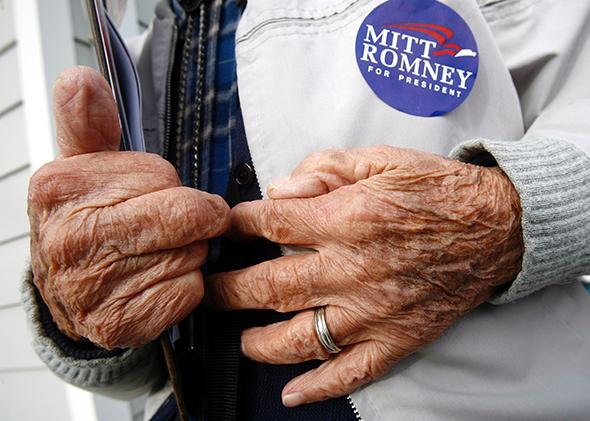The Republican Party controls Congress, the majority of governorships, and the majority of statehouses. But, argues Daniel McGraw in Politico Magazine, it’s dying. Literally. “Since the average Republican is significantly older than the average Democrat, far more Republicans than Democrats have died since the 2012 elections,” he writes. “To make matters worse, the GOP is attracting fewer first-time voters. Unless the party is able to make inroads with new voters, or discover a fountain of youth, the GOP’s slow demographic slide will continue election to election.”
It’s hard to argue the numbers of McGraw’s assessment. Republican voters are disproportionately elderly, and it’s safe to assume a large slice of the party’s voters will die by 2016. At the same time, at least since 2008, the number of young people who become Republicans has declined from its earlier highs. Barring a major shift in the youth vote from its allegiance to the Democratic Party (young voters reject Republicans, 35 percent to 65 percent), Democrats will pick up 2 million new voters in 2016. By contrast, notes McGraw, the youth split plus the death numbers “puts Republicans at an almost 2.5 million voter disadvantage.”
There’s no doubt the GOP is in a tight spot. But it’s too much to argue, as McGraw does, that the party is primed for decline. For starters, the trends McGraw identifies for 2016 were also true in 2012 and 2008. In fact, for most of the last decade, it has generally been true that—with a broad, diverse coalition—Democrats have had an easier time getting and replacing voters than Republicans, who rely on a demographically narrow group of whites in both the South and the nation’s interior. Nevertheless, Republicans have won two midterm elections and come close to grabbing the White House from an incumbent president. The reason it didn’t had less to do with its aging base and more to do with the macroconditions of the 2012 election. The economy was just good enough to give President Obama a second term. Add higher unemployment and lower growth, however, and you’re likely looking at President Romney in 2013.
The same will go, in general, for 2016. For as much as Republicans are at a demographic disadvantage, it is also true that their ultimate performance depends on the fundamentals: If Obama’s approval rating declines and the economy hits a snag, then voters will turn against Democrats and Republicans will recover the White House, even as they struggle to replace their core supporters. That’s just how elections work; even when a party is nationally unfavored, conditions can give them a shot.
And in the medium term, Republicans will begin to make up for the death rate of their most loyal supporters. Eventually, the GOP will find a working national majority, even if the country becomes as brown and liberal as some analysts project. Put differently, the real question of Republicans and elderly voters isn’t if the party will die—the only time a major party “died” is when it was killed by sectional disputes around slavery—it’s whether a future, younger Republican Party will still have a conservative movement.
Right now, the GOP is a mass vehicle for ideological, small-government conservatism, which Republicans pursue across all branches of government across the entire country. Gov. Rick Scott’s agenda in Florida looks a lot like Gov. Scott Walker’s in Wisconsin, which in turn will influence any Republican who becomes president in 2016. And this conservatism is fueled by the older, white base of the Republican Party which disdains liberal priorities and liberal voters—from union members to immigration activists—with terrible ferocity.
What happens when those voters disappear from national electorates, as they will over the next decade? And what happens if the next cohort of Republican voters—their children and grandchildren—have more liberal views on social issues and the economy? Does movement conservatism survive as the dominant ideological force in the Republican coalition? Or will new Republican voters—from young white transplants to states like Arizona to upwardly mobile Latino immigrants in Georgia—adopt and change conservatism to meet their needs?
Your best bet is for the latter. Any Republican Party that drives in 2024 or 2028 is one that looks substantially different from the one that exists today. No, that doesn’t mean it’s a diet version of the Democrats, but that it’s responding to a different set of voters than it has now. In all likelihood, it’s reconciled itself to the reality of the welfare state and works to alter its shape and incentives. It’s more permissive on public morality—tolerant of same-sex marriage, for instance—but still a home for more traditional voters who oppose abortion and are uncomfortable with rapid social change.
Demographic trends and social movements can fracture coalitions and create new ones. But—barring catastrophe—the parties survive. The future will have a Republican Party, and it will be conservative. It just won’t be the same kind of Republican Party with the same kind of conservatism.
